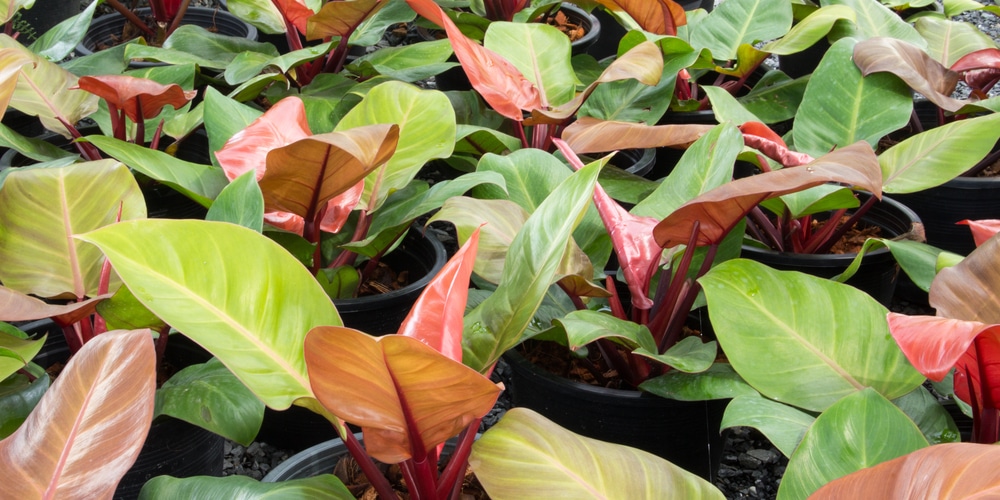There are many reasons that your Philodendron Erubescens’s leaves have started turning yellow. Overwatering, underwatering, incorrect humidity, poor lighting, incorrect nutrients, and insect infestation can all produce yellow leaves. It can be hard to determine precisely what the problem is as the symptoms are very similar.
Let’s look at the most common reasons that your Philodendron Erubescens’s leaves may be turning yellow. We’ll also give you some tips to help revitalize your plant so that its leaves look green and healthy.
Philodendron Erubescens Leaves Turning Yellow Causes
It May Be Normal
It’s worth noting that a Philodendron Erubescens will drop old leaves as new growth occurs. Older leaves may start to change color and will become yellow or brown. This is a natural process and is nothing to worry about as long as only one or two leaves turn yellow at a time.
If you notice that your Philodendron has lots of yellow leaves or the edges of several leaves are starting to discolor, this indicates a problem. Yellowing foliage indicates that your plant is sick and may need some extra care to recover. Here are some of the most common reasons a Philodendron Erubescens turns yellow:
Incorrect lighting (Very Likely)
Philodendrons grow best in medium sunlight when grown outside. If you’re keeping your philodendron as a house plant, it should be placed in bright indirect sunlight.
Philodendron Erubescens in particular likes to be in an east or west-facing window (east, facing the sunrise would be ideal). This limits the amount of direct sun that it gets to either sunset or sunrise.
Don’t leave your plant in the full sun, or the foliage may burn, and this could cause yellow spots to occur. Your plant can even be burnt through glass, so don’t leave it on a windowsill in hot weather. Philodendrons are fairly sensitive and can become damaged if placed too close to air conditioning units or heating vents.
When a philodendron is grown in areas with insufficient sunlight, it may also suffer. Philodendrons are likely to turn yellow if they are grown in the shade. The leaves will yellow from the tips and may eventually turn completely yellow.
Nutrient deficiency
Yellowing leaves can be a result of a nutrient deficiency. If there isn’t enough iron or magnesium in the soil, the plant’s leaves will become discolored. Iron is an essential nutrient as it helps plants produce beautiful green foliage. Other important minerals, including magnesium, zinc, and calcium, will affect the leaf’s colors if there’s a deficiency.
If your Philodendron Erubescens has V-shaped yellow spots on its foliage, this is an indication that it has a magnesium deficiency. Nutritional deficiencies can be easily solved by providing your plant with a good quality house plant fertilizer on a monthly basis. Most plants will quickly recover after receiving the nutrients they need.
Overwatering (Very Likely)
Philodendron Erubescens’ are not prone to many ailments. They are solid and hardy plants that can survive in different conditions and thrive. They don’t need a lot of water unless you are propagating a Philodendron Erubescens.
Overwatering is one of the most common causes that philodendrons leaves turn yellow. These plants shouldn’t be overwatered. It’s best to water your plant using the ‘soak and dry’ method; wait until the plant’s topsoil has completely dried out before watering again. It’s also a wise idea to plant your philodendron in soil that’s well-draining.
If you’ve overwatered your plant, it may be suffering from root rot. This is a fungal disease that can kill the plant. When the roots begin to rot, they cannot absorb the water and nutrients that the plants require, which causes the leaves to turn yellow.
To save your plant, you can report it using new soil and a new pot. Cut off the infected roots and treat your plant with a fungicide. Be careful not to overwater your plant again, or the problem will be repeated.
Underwatering
Neglecting your Philodendron Erubescens by underwatering will also cause the leaves to turn yellow. When a philodendron is underwatered, its soil and leaves will feel very dry. The leaves will begin to discolor and look wilted. Eventually, the leaves will turn brown and fall off. Ensure that your plant is watered regularly to solve this problem.
Low Humidity
Low humidity can cause the leaves of a philodendron to dry out and become yellow. As philodendrons are tropical plants, they require humidity of between 60 and 85%. Try misting your plants every morning with a fine spray to improve their condition. You could also get a humidifier, or even put it in the bathroom…
Pest infestation
Philodendrons can be affected by insect infestation. Aphids are common pests that suck sap from the leaves and stems of plants. This causes the foliage to discolor. Spots will likely appear on your plant’s leaves, and you’ll be able to see insects. Aphids can be showered off your plant or killed with an insecticide spray.
Conclusion:
As you can see, many things cause the leaves of a Philodendron Erubescens to turn yellow. Determining what the problem is, is the first step to improving your plant’s health. The most common reasons that a philodendron’s leaves discolor include over or under watering, incorrect lighting or humidity, pests, and nutritional deficiencies.
